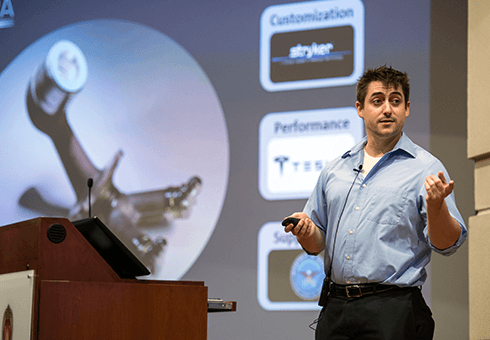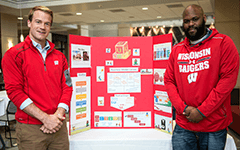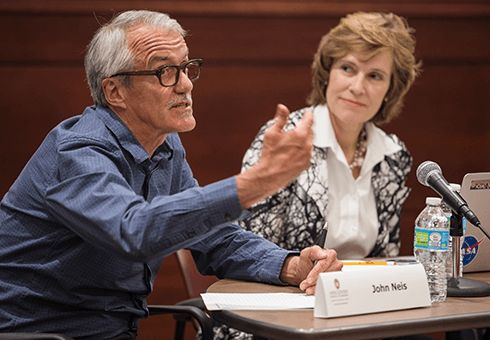
Even with years of experience, John Surdyk says he still can’t predict the future.
“If I’ve learned nothing else, I know I’m terrible at picking winners,” he says. “You just don’t know. This competition isn’t designed to say ‘here are the companies who are going to do well.’ We try to surface the promising ideas and help the students explore further with the money that they get, the relationships that they build, and the confidence that they acquire.”
Surdyk is referring to the WSB Business Plan Competition, an annual event he helms that gives University of Wisconsin–Madison students the opportunity to present a startup project to judges, receive feedback on their pitch and business plan, and compete for cash to fuel their ideas. Formerly known as the G. Steven Burrill competition, the contest took a gap year in 2016 before relaunching in 2017. Surdyk is director of WSB’s Initiative for Studies in Transformational Entrepreneurship (INSITE), which hosts the competition in conjunction with the Weinert Center for Entrepreneurship. The event was also sponsored in part this year by American Family Insurance, along with the AARP Foundation and Wisconsin Alumni Research Foundation (WARF).
“What sets this competition apart from competitions at other universities or even on this campus is that it’s about a credible plan of action to build an organization that can take a product or service to market,” Surdyk says.
The event has gained a national reputation, even landing a spot on The New York Times list of the country’s top student competitions. Since the competition began in 1998, Surdyk has seen steady growth in the caliber of projects and innovative ideas. The presentations are so competitive now, Surdyk says, that placing second is an impressive achievement.
This year’s competition featured 63 students across 24 teams that represented 26 majors. While many of the participants present project ideas rooted in technology, bioscience, or engineering, the event also attracts nonprofit and social purpose ventures. Keeping the competition open to students from all majors “is how we level the playing field and honor the diversity of ideas that come out of the different parts of our campus,” says Surdyk.
A benefit to all competitors
Brandon Walker (Ph.D. ’17), CEO of Linectra, took home this year’s $10,000 grand prize for developing a high-speed 3-D metal printer. Walker, who holds a doctorate in medical physics and is a 2012 graduate of the Morgridge Entrepreneurial Bootcamp (MEB) sponsored by INSITE and the Weinert Center for Entrepreneurship, says he had been following the competition for some time and was happy to see it return while he was still eligible and could apply the skills he learned at WEB.
“The experience gained during this competition and the award will be a great benefit to us as we move toward a company launch,” Walker says.

Three finalist teams also received $500 prizes, including Brandon Shields (MBA ’17) and Scott Maurer (MBA ’17), a pair of Wisconsin MBA students who developed U-sit, an app that helps university-affiliated parents find on-demand childcare. The other finalist teams illustrate the competition’s diversity of ideas: NovoMoto installs solar panels in the Congo, while Pathogenomica applies high-speed genetic sequencing to detect pathogens.
Surdyk recalls how Madison success story EatStreet—a food delivery company founded by UW–Madison students that has grown to 150+ employees—didn’t even place its first time in the competition. The team came back the next year and won after learning the difference between knowing technology and knowing one’s customer. Matt Howard, the startup’s co-founder and CEO, returned to the competition again in 2017, this time as a judge.
“Winning the competition was the reinforcement and momentum we needed to give our idea traction with restaurants and customers,” says Howard. “The experience of pitching the EatStreet business idea in a highly competitive environment helped prepare us to raise future investment capital to grow the business.”

Building a network of entrepreneurs
Glancing at the most recent contestant list, Surdyk can tick off dozens of names—both participants and judges—who had previously participated in the Business Plan Competition or WEB. It’s proof that the program and its affiliated partners are empowering the entrepreneurial spirit in students not just at the Wisconsin School of Business, but all across campus.
Aaron Olson, a doctoral engineering student and WEB alum who is part of the finalist team NovoMoto, visited this year’s bootcamp sessions to share his experience and lessons learned from the Business Plan Competition with those who are at the very beginning of the journey.
Building a network of entrepreneurs in that spirit of collaboration and knowledge-sharing is what the competition is all about, Surdyk says.
“What I like about this system is it’s not like we have a competition that just shoots people out on their path to profit and success without any acknowledgement of their roots,” reflects Surdyk. “These are people that are trying to give back even while they are students. That’s the power of the competition. It’s not the money. What
we can do to transform the expectations and aspirations of students—that’s going to do a lot more to unlock the Wisconsin Idea than $10,000 for equipment and supplies.”
Tags: